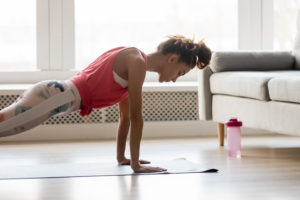
If you’ve been at home the last few weeks, the at-home workout has likely crossed your mind. Of course, you might not have the space to set up a full gym. Further, some quick online searches reveal fitness equipment is in short supply these days.
COVID-19 has changed the way we live and exercise. It creates a huge opportunity for people to abandon their exercise routine, which can lead to losses in muscle strength and size, along with diminishing cardiovascular health.
But you don’t need much equipment, if any, to work out at home. And spending as little as 30-minutes doing resistance exercise per day can help keep your muscles engaged and strong, as well as improve heart health.
Even if you can’t spare 30-minutes per day, there is evidence that just one hour per week of weight training, which includes body weight, can reduce the risk for heart attack and stroke.
No matter what, your exercise routine will change at home. You may only have a couple of dumbbells or resistance bands. You may have nothing at all. In some cases, you may get creative and use props like water jugs to create resistance.
At-home workouts should be guided by efficiency. Therefore, you want to focus on compound movements involving multiple muscle groups. Using squats, pushups, and bent rows as your core exercises are likely the most effective exercises under these circumstances.
Squats and pushups can be performed using bodyweight. If needed, added resistance can be applied with elastic bands or kettlebells. If you find you’re able to do 10 repetitions of each without much trouble, simply do more repetitions.
Bent-over rows to work the back will require something to provide resistance. Dumbbells, kettlebells, bands, milk or water jugs, etc. are all suitable. You can use a chair, bench, or sturdy ottoman to support through the motion.
Doing three sets per day of each exercise is a good way to get started.
For those of you who may be more advanced, performing circuits with more movements and volume might be more beneficial.
Working out at home during this period can help prevent muscle loss and keep your heart strong.